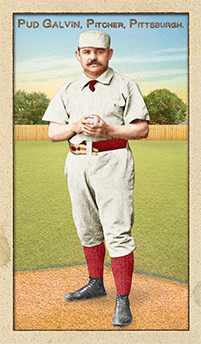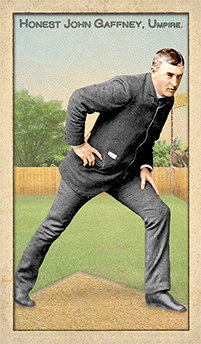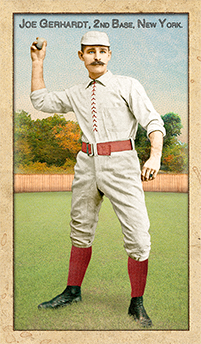- Series: Beginnings: 1880's
- City: New York
- Team: Giants
- League: National League
John Joseph Gerhardt (1855-1922) played for 11 teams over his 15-year career, primarily at second base. He averaged only .227 at the plate but led the league at times in key fielding categories. He played for the biggest teams of his day: the Giants, Mutuals, and Reds and also for the more obscure: the Washington Blue Legs, the Baltimore Canaries, the Louisville Eclipse and the Brooklyn Gladiators.
- Gerhardt was named manager of two of his teams: Louisville in 1883 and St. Louis in 1890
- A 1922 NY writer compared him favorably to the best: “None had anything on Move Em Up Joe Gerhardt”
- Series: Beginnings: 1880's
- City: New York
- Team: Giants
- League: National League
William M. George (1865-1916) was a left-handed pitcher & outfielder for two major league teams over 3 years in the late 1880s. He debuted as a pitcher for the NY Giants in ’87. During his two seasons on the mound, George went 5-10 with a 4.51 ERA. His mediocre performance led to him being released by the Giants in June of ‘89. He had not gotten into a game that year in NY. The native of Bellaire, OH tried out with the American Association’s Columbus Solons in July of 1889. They picked him up as an outfielder. Bill got into five games that summer, getting 4 hits and 3 RBI in 17 at-bats & was released in August, ending his major league experience.
- Bill’s record in ’88 was 2-1 with a 1.34 ERA. But, with Tim Keefe winning 35 with an 1.74 ERA & Mickey Welch winning 26 with a 1.93 ERA, the competition was stiff on the pennant winner

- Series: Beginnings: 1880's
- City: Washington, D.C.
- Team: Nationals
- League: National League
Franklin Washington Gardner (1859-1914) is proof of the power of eulogy. His obit writer in Sporting Life on Aug 22, 1914 said: “…from 1878 until about 1890 [Gardner] was one of the best ball players in the country.” This of one who compiled a lifetime .233 average, was 2-12 during sporadic stints on the mound, and played for 8 clubs in a seven-year tenure in the majors – only once playing consecutive seasons for the same team. He was suspended and fired more often than he changed uniforms. Bill James counts Gid among the 8 men most worthy of the title “Drinking Men” of the 1880s, an era not known for sobriety and decorum. Gardner’s intro to the big leagues came with the Troy Trojans in 1879 after impressing many in New England’s small towns. He made it to age 32 when, upon his father’s death, Gid went home to live with mom and never held a job again. Evidence of how endearing this rogue could be: he mysteriously disappeared from his semi-pro Norwich team in 1890 for weeks mid-season, yet “was cheered by a few hundred fans at the train depot when he returned.”
- His best year was ’83 with the Orioles, batting .273 in 42 games. In September, manager Billy Barnie fined Gid for drunkenness on a road trip to NY

- Series: Beginnings: 1880's
- City: Pittsburgh
- Team: Alleghenys
- League: National League
- Hall: National Baseball Hall of Fame
James Francis Galvin (1856-1902) sported some colorful nicknames: Pud, Gentle Jeems and The Little Steam Engine, indicative of his renown. Pud was baseball’s first 300-game winner. He pitched for six teams over 15 years, and remains the only player to win 20+ games in ten seasons and not win a pennant. Only Cy Young pitched more innings or hurled more complete games, a testimony to the extraordinary demands placed on starters in the 19th century. Perhaps no pitcher of any era accomplished so much by overcoming a distinct physical limitation. In Galvin’s case, it was his small hands which left him unable to completely grip a baseball. He couldn’t throw the curve so he adapted, becoming an expert in “drops, straight balls and the different artifices known to pitchers to deceive the batter” as he told a friend. As his steam engine nickname suggests, Pud just rolled right at the hitter with power and durability yet with amazing finesse, especially in holding runners on base. Buck Ewing was a great admirer and said he wouldn’t have had anyone attempting steals with Galvin on the mound.
- Galvin threw no-hitters in 1880 and ‘84
- Began and ended his long career in St Louis with the NA’s Brown Stockings and NL’s Browns
- Elected to Hall of Fame: 1965
- Galvin's uniform color on this card was changed in April, 2017 from black to red to reflect recent reliable research by Craig Brown & friends at Threads of Our Game. Nine cards had been previously released featuring a black uniform.

- Series: Beginnings: 1880's
- League: National League
John H. Gaffney (1855-1913) was denied a major league career as a third-baseman by an arm injured throwing a snowball. Baseball may have lost an infielder but gained its first great umpire when, in 1884, Gaffney joined the National League cadre. Renowned for his expert pitch calling, no official presided over more post-season games in the 19th century than “Honest John.” His general baseball expertise led to his being hired to manage the Washington D.C Nationals club in 1886-87. Gaffney pioneered important changes in umpiring practices including using multiple refs, positioning of field umps and defining foul balls. The umpire bore the brunt of fan outrage in a day when violence was all too prevalent on the field. Perhaps succumbing to such pressure, John was felled by the scourge of his era, alcoholism, and left the majors in 1894. Brief failed attempts to revive his NL career did, however, allow him to become one of only two, with Tom Lynch, to officiate twelve seasons in baseball’s first century.
- Dubbed the “King of the Umpires”, John was so admired by players that Connie Mack and Hank O’Day surprised him with a diamond ring in appreciation for his management skills during their ’87 Series




